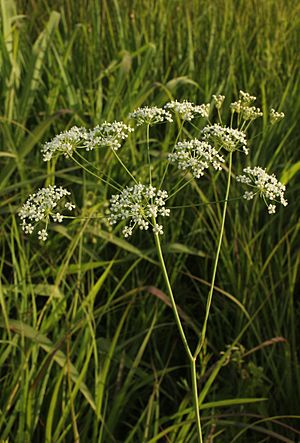Eastern yampah facts for kids
Quick facts for kids Eastern yampah |
|
|---|---|
 |
|
| Perideridia americana photographed in Missouri tallgrass prairie. | |
| Conservation status | |
| Scientific classification | |
| Genus: |
Perideridia
|
| Species: |
americana
|
Perideridia americana is a type of flowering plant. It belongs to the Apiaceae family, which is also known as the carrot or parsley family. This plant has two common names: eastern yampah and wild dill.
You can find wild dill in 12 states across the Midwestern United States. These states include places like Missouri, Illinois, and Ohio. In some of these states, like Missouri, it is a special plant. It is listed as a "species of concern." This means people are worried about it and want to protect it. In other states, it might even be listed as threatened or endangered. This means there are not many of these plants left, and they need help to survive.
Contents
About Wild Dill
Wild dill likes to grow in certain types of soil. It prefers soil that contains a lot of calcium carbonate. This kind of soil is often found in areas with limestone.
Where Does Wild Dill Grow?
This plant can be found in several different natural places. It grows in glades, which are open, rocky areas. It also thrives in upland prairies, which are large grasslands. Sometimes, you can even spot it growing in forests.
What Does Wild Dill Look Like?
Wild dill is a perennial herb. This means it lives for more than two years. It grows back each year from its roots.
Stems and Leaves
The plant has tall, straight stems. These stems can grow to be between 50 and 120 centimeters tall. That's about 1.5 to 4 feet high! Its leaves are arranged alternately along the stem. They are also "doubly pinnate," which means they are divided into smaller leaflets. These leaflets are long and pointy.
Flowers and Fruits
Wild dill produces many small, white flowers. These flowers grow in round clusters. Several of these clusters then form a larger, umbrella-shaped group. This type of flower arrangement is called a compound umbel. After the flowers bloom, the plant produces small fruits. These fruits are about 3 to 5 millimeters long. They have five thin ridges along their sides.


